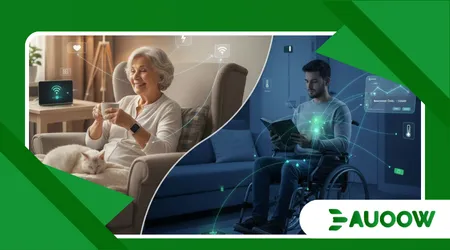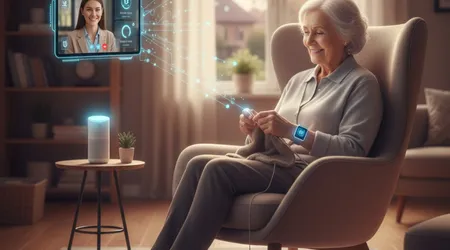IoT-Based Remote Monitoring: Keeping Vulnerable Users Safe at Home

IoT-Based Remote Monitoring defines a crucial frontier in assistive technology, providing safety without sacrificing independence.
This networked approach utilizes smart sensors and connected devices to watch over vulnerable individuals. It revolutionizes how we care for the elderly, disabled, and those with chronic conditions.
This technological embrace of care ensures dignity and immediate response capability.
The global aging population surge demands innovative, scalable healthcare solutions. Traditional in-home care, while essential, is often expensive and limited in continuous coverage.
Technology offers a compelling alternative to institutionalization. The Internet of Things (IoT) provides the framework for this new model of proactive vigilance.
This system leverages ambient and wearable sensors to track vital signs and activity patterns. Data streams flow constantly to caregivers or healthcare providers for immediate analysis.
It transforms a reactive care model into a highly predictive one. Understanding the immense potential of IoT-Based Remote Monitoring is vital for modern health policy.
What are the Core Functions and Components of an IoT-Based Remote Monitoring System?
How Does the Technology Track Well-being Without Intrusion?
Modern remote monitoring systems utilize two main types of sensors: ambient and wearable. Ambient sensors, like motion detectors and smart floor mats, track daily routines and movements.
They can detect deviations, such as prolonged inactivity or unusual sleep patterns, without relying on cameras. This provides surveillance without invading privacy.
Wearable sensors, often disguised as watches or patches, track physiological data continuously. These monitor heart rate, blood pressure, glucose levels, and even oxygen saturation.
This biomedical data offers a real-time snapshot of the user’s health status. The constant flow of information allows for trend analysis.
These diverse sensors communicate through a secure home hub, leveraging WiFi or cellular networks. The data is then encrypted and transmitted to cloud-based platforms.
These secure servers use complex algorithms, often powered by Artificial Intelligence (AI). This sophisticated backend analyzes subtle changes that might signify a developing health crisis.
++ Voice-Controlled Medication Dispensers: A Growing Trend in Elderly Care
Why is AI and Predictive Analytics Essential for Safety?
The sheer volume of data collected by IoT-Based Remote Monitoring systems requires automated intelligence.
AI algorithms analyze patterns of life the time the refrigerator is opened, the length of sleep, the pace of walking.
They establish a ‘normal’ baseline for the user. Any significant deviation triggers an alert, moving beyond simple emergency buttons.
For example, a sudden decrease in mobility or an increase in nocturnal bathroom visits could signal an impending urinary tract infection.
This early identification enables intervention before a hospitalization is required. Predictive analytics turns raw data into actionable medical intelligence. This capability significantly improves outcomes for chronic disease management.
A study in 2025 highlighted the effectiveness of this predictive capability. AI-powered fall detection systems have demonstrated a sensitivity of up to 98%, minimizing false alarms.
This accuracy is paramount for maintaining caregiver trust and system effectiveness. It moves technology from simple monitoring to genuine preventative care.

How Does IoT-Based Remote Monitoring Improve Healthcare Economics and Quality of Life?
What are the Cost Benefits Compared to Traditional Care?
The financial burden of institutional care or round-the-clock professional home assistance is substantial. IoT-Based Remote Monitoring offers a compelling, cost-effective alternative.
The monthly cost of an RPM program is often a fraction of a single day of institutional care. This economic advantage is driving rapid market adoption.
The global smart home healthcare market, heavily driven by RPM, is projected to grow from approximately $29.73 billion in 2025 to over $284 billion by 2034.
This aggressive growth reflects the urgent need for scalable, affordable solutions fueled by aging demographics. The investment is clearly recognized as both ethical and profitable.
Furthermore, RPM contributes to significant savings by reducing expensive hospitalizations and readmissions. By enabling timely, proactive care, minor issues do not escalate into emergencies.
This keeps patients at home, which is better for their health and well-being. The economic value extends across the entire healthcare system.
Also read: The Ethics of AI in Assistive Technology: Inclusion at the Design Stage
How Does RPM Reduce the Need for Hospital Readmissions?
Continuous, real-time tracking is a game-changer for patients with chronic conditions like heart failure or COPD.
A slight, monitored weight gain, for instance, might indicate fluid retention in a heart failure patient. This early warning allows a nurse to adjust medication remotely. Such timely interventions prevent an acute crisis.
A study published in 2025 demonstrated the clinical efficacy of this approach. Healthcare facilities using Remote Patient Monitoring (RPM) reported a reduction in 30-day hospital readmissions for heart patients by as much as 50%.
Read more: Exoskeletons at Home: From Rehabilitation to Daily Use
This massive reduction in costly and stressful readmissions proves the technology’s worth. RPM supports patient adherence and post-discharge recovery.
The ability to provide personalized, continuous care empowers the patient and supports the family caregiver. It creates a robust safety net around the user at all times.
The seamless collection of data facilitates better communication between the patient and their care team.
Why Do We Need a Thoughtful Approach to Ethics and Privacy in Remote Monitoring?
What Are the Key Ethical Concerns Surrounding Constant Surveillance?
The continuous collection of personal health and habit data raises significant ethical questions. Users must grant genuinely informed consent for the level of monitoring involved.
The challenge lies in ensuring that consent is fully understood, especially by users with cognitive impairments. Who owns the data and how is it used?
We must actively guard against the technology becoming a means of subtle control or over-surveillance. The system’s primary role is to assist, not to dominate the user’s life.
The successful implementation of IoT-Based Remote Monitoring requires a balance between safety and autonomy.
| Feature | Traditional In-Home Care (4 hours/day) | IoT-Based Remote Monitoring (RPM) |
| Monitoring Window | Intermittent (Fixed visit times) | Continuous (24/7 real-time data flow) |
| Fall Detection | Manual Alert (Requires user action) | Automatic (Sensor/AI-driven immediate alert) |
| Data Collection | Subjective (Caregiver reports, patient memory) | Objective (Quantifiable, time-stamped biometric data) |
| Cost | High (Hourly rate, travel fees) | Moderate/Low (Fixed monthly subscription) |
| Intervention Speed | Slow (Response based on next visit or call) | Immediate (Instant alert to caregiver/medical service) |
Preventing a Medical Emergency
Mrs. Eleanor, 88, lives alone with early-stage heart failure. Her wearable monitor, part of her IoT-Based Remote Monitoring system, detects a subtle, two-day trend of elevated resting heart rate and declining sleep quality.
The AI flags this change as potential decompensation. Her dedicated nurse receives the high-priority alert.
The nurse calls Mrs. Eleanor, verifies symptoms, and adjusts her diuretic medication immediately, preventing a severe fluid buildup that would have necessitated an A&E visit.
The Dignity of an Unnoticed Fall
Mr. David, 75, slips on his rug at 3 AM. He is uninjured but disoriented and cannot reach his personal alarm pendant.
His ambient monitoring system, using floor pressure sensors, detects the sudden impact and subsequent stillness. It automatically generates an alert after 90 seconds of no movement.
His daughter is notified and calls him, discovering his distress. The system provided life-saving intervention without the need for constant, intrusive cameras or human observation.
Conclusion: Securing Independence Through Connectivity
The conversation around IoT-Based Remote Monitoring is moving past novelty and into necessity. This technology is a powerful tool for promoting autonomy and improving clinical outcomes for vulnerable users.
It delivers a superior standard of care compared to sporadic visits, all while reducing the overall cost to the health system. The benefits of early intervention and reduced hospitalization are compelling.
We must approach its implementation with unwavering focus on security and privacy standards.
Only through ethical design and responsible data management can we truly unlock its potential. Investing in this technology is investing in the future dignity of our loved ones.
Have you or a family member benefited from remote monitoring? Share your experience with the technology’s balance of privacy and safety in the comments below.
Frequently Asked Questions (FAQ)
Is IoT-Based Remote Monitoring the same as a traditional “panic button” or PERS (Personal Emergency Response System)?
No. A traditional PERS relies on the user being able to manually press a button during an emergency. IoT-Based Remote Monitoring is proactive and passive.
It automatically detects anomalies like falls, changes in vital signs, or deviations from normal routines, often alerting caregivers before a full-blown emergency occurs.
How much internet bandwidth does an RPM system require?
Most modern RPM systems require surprisingly little bandwidth. They typically transmit small packets of data (sensor readings, vital signs) intermittently.
A standard home broadband or even reliable cellular connection is usually sufficient to support the system without disruption.
What if the power goes out or the internet fails?
Reputable IoT-Based Remote Monitoring systems include multiple layers of redundancy. Many devices feature battery backups and utilize cellular networks (like 4G/5G) as a failover when home Wi-Fi is down.
These crucial features ensure that essential monitoring continues even during utility outages.
How are patient data privacy and security protected?
Data is protected by robust encryption protocols, both during transmission and storage, often meeting stringent healthcare compliance standards (like HIPAA or GDPR).
Companies must implement strict access controls, ensuring only authorized caregivers and medical professionals can view the sensitive data. Transparency regarding data handling is key.
Who is responsible for responding to the alerts generated by the system?
The response protocol is customized based on the user’s needs. Alerts are typically tiered: low-level alerts (e.g., slight temperature change) go to a designated family member or case manager.
High-level alerts (e.g., confirmed fall, critical vital sign drop) go directly to a professional monitoring center or emergency services.
